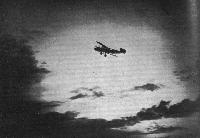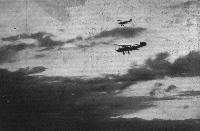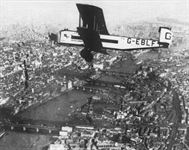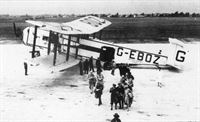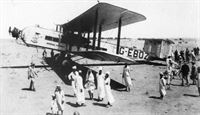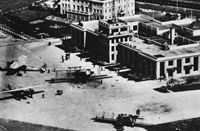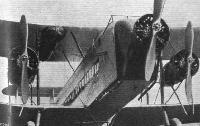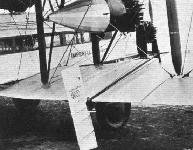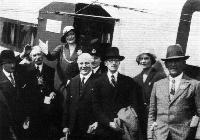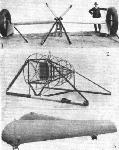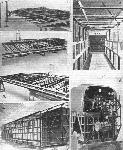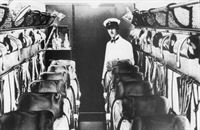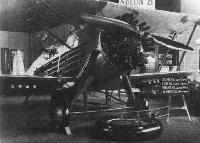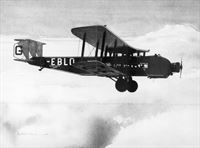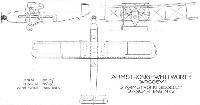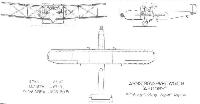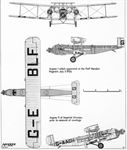
Описание
Страна : Великобритания
Год : 1926
Пассажирский самолет с экипажем из 2-3 человек
Armstrong Whitworth Argosy
Когда в 1925 году молодая авиакомпания "Imperial Airways" решила использовать отныне только многомоторные самолеты, фирма "Armstrong Whitworth" стала одним из трех счастливчиков, получивших от нее заказы на такие машины. В результате по требованиям от 1922 года - разработка трехмоторного самолета с дальностью полета 805 км - компанией был создан первый ее пассажирский самолет - большой биплан Argosy с неубираемым шасси. Первый полет был выполнен в марте 1926 года, уже после получения заказа от "Imperial Airways". Второй Argosy взлетел через три месяца и стал первым самолетом, переданным заказчику.
Менеджеры "Imperial Airways" не теряли времени - эксплуатация самолета на линии Кройдон (Южный Лондон) - Париж началась уже 16 июля 1926 года, а 1 мая 1927 года на эту линию вышел самолет класса люкс, получивший собственное имя "Silver Wing".
В базовом варианте он перевозил до 20 пассажиров в закрытом салоне, командир и второй пилот размещались в открытой кабине, оборудованной сразу за фюзеляжным двигателем. Количество пассажирских кресел сокращали на два, если в полет брали стюарда.
"Imperial Airways" вскоре заказала еще три (заказ чуть позже увеличили до четырех) самолета, эксплуатация которых началась в 1929 году. Самолеты второй серии получили обозначение Argosy Mk II и оснащались двигателями Armstrong Siddeley Jaguar PVA. что позволило увеличить максимальную взлетную массу на 544 кг. После выполнения заказа на постройку Argosy Mk II моторами Jaguar IVA переоснастили и три Argosy Mk I.
30 марта 1929 года Argosy открыл первую авиапочтовую линию компании "Empire", которая связала Британию с Индией. Почту доставили сначала в Базель, затем поездом в Геную, а далее - по воздуху с многочисленными посадками - в Карачи. Один Argosy сгорел после столкновения с землей во время выполнения тренировочного полета в Кройдоне (ныне южная часть Лондона) в апреле 1931 года, через два месяца был потерян еще один самолет, выполнивший вынужденную посадку у Асуана. К счастью, в инцидентах никто не пострадал, а вот в марте 1933 года возникший в полете над Бельгией на борту еще одного Argosy пожар привел к катастрофе самолета и гибели трех членов экипажа и 12 пассажиров. Последние Argosy списали после начала эксплуатации Н.P.42. Дольше всего летал Argosy Mk II "City of Manchester", купленный в июне 1935 года авиакомпанией "United Airways" и эксплуатировавшийся летом 1936 года для полетов в Блэкпул (Ланкашир, Англия). Затем его передали "British Airways", а в декабре 1936 года - списали.
Модификации
Argosy Mk I: самолет первой серии, изначально оснащен тремя моторами Jaguar IIIA, замененными затем на Jaguar IVA; характеристики как у Mk II, за исключением дальности полета (531 км), массы пустого (5443 кг), максимальной взлетной массы (8165 кг), размаха крыла (27,64 м), длины (20,07 м), высоты (6,05 м) и площади крыла (175,22 м')
Argosy Mk II: самолеты второй серии с тремя моторами Jaguar IVA; несколько упрощено управление за счет установки регулировочных пластин на нижнем крыле
ТАКТИКО-ТЕХНИЧЕСКИЕ ХАРАКТЕРИСТИКИ
Armstrong Whitworth Argosy Mk II
Тип: пассажирский самолет с экипажем из 2-3 человек
Силовая установи: три звездообразных ПД Armstrong Whitworth Jaguar IVA мощностью no 420 л. с (313 кВт)
Характеристики: максимальная скорость на оптимальной высоте 177 км/ч; крейсерская скорость на оптимальной высоте 145-153 км/ч; время набора высоты 915 м - 4 мин 30 с; дальность полета 837 км
Масса: пустого 5484 кг; максимальная взлетная 8709кг
Размеры: размах крыла 27,53 м; длина 20.42 м; высота 6,10 м; площадь крыла 174,01 м'
Нагрузка: до 20 пассажиров
Описание:
- Armstrong Whitworth Argosy
- Flight, July 1926
THE ARMSTRONG-WHITWORTH "ARGOSY” - Flight, August 1926
THE ARMSTRONG-WHITWORTH "ARGOSY” - Flight, March 1929
NEW ARMSTRONG-WHITWORTH "ARGOSIES" - Flight, June 1929
BRITISH AIRCRAFT AT OLYMPIA
Фотографии
-
Мировая Авиация 33
Регистрационный номер: G-EBLF [18] "City of Glasgow" - первый Argosy Mk I, поставленный авиакомпании "lmperial Airways". Самолет изображен в оригинальной голубой окраске.
-
Air Enthusiast 2000-11 / G.Warner - Founding Fathers (2)
Регистрационный номер: G-EBLF [18] Armstrong Whitworth Argosy I G-EBLF, Imperial Airways
-
Air Enthusiast 2000-11 / G.Warner - Founding Fathers (2)
Регистрационный номер: G-EBLO [6] Armstrong Whitworth Argosy I G-EBLO, 'City of Birmingham', Imperial Airways.
-
Air Enthusiast 2000-11 / G.Warner - Founding Fathers (2)
Регистрационный номер: G-AACH [5] Armstrong Whitworth Argosy II G-AACH, Imperial Airways
-
Aeroplane Monthly 1981-05 / R.Williams - Imperial Argosies (2)
Регистрационный номер: G-AACH [5] Argosy II of Imperial Airways, prior to removal of cowlings
-
Flight 1926-07 / Flight
THE ARMSTRONG-WHITWORTH "ARGOSY": Three-quarter front view of the latest 20-passenger commercial aeroplane. The port wing engine is hidden by the nose of the fuselage. The engines are Armstrong-Siddeley "Jaguars."
-
Flight 1926-07 / Flight
THE ARMSTRONG-WHITWORTH "ARGOSY": Front view, from which the arrangement of the three Siddeley "Jaguar" engines may be seen.
-
Flight 1926-07 / Flight
Armstrong Whitworth "Argosy" (Three Armstrong-Siddeley "Jaguars") But for the fact that there is not a great deal of difference between a civilian passenger aeroplane and a service troop carrier, it would be somewhat curious to see, in what is a purely Service Display, a commercial aeroplane. Doubtless it is for that reason that the Armstrong Whitworth "Argosy" is one of the machines which will take part in the "Fly-past." As the "Argosy" is illustrated and described in some detail elsewhere in this issue, there is little need to do other here than to state that the machine, is the only three-engined aeroplane in the Display.
-
Aeroplane Monthly 1981-04 / R.Williams - Imperial Argosies (1)
The photograph was taken during the prototype's participation at the Hendon RAF Pageant on July 3, 1926, where it wore the "new types" number 15.
-
Aeroplane Monthly 1981-04 / R.Williams - Imperial Argosies (1)
Регистрационный номер: G-EBLF [18] THE ARMSTRONG-WHITWORTH "ARGOSY": Another 1926 machine - a marked advance in airliner design - fitted with three Armstrong-Siddeley "Jaguars."
The prototype Argosy in early Imperial Airways' colour scheme of dark blue and silver. -
Aeroplane Monthly 1981-04 / R.Williams - Imperial Argosies (1)
Регистрационный номер: G-EBLF [18] The photograph was taken during the prototype's participation at the Hendon RAF Pageant on July 3, 1926, where it wore the "new types" number 15.
-
Flight 1926-10 / Flight
Регистрационный номер: G-EBLF [18] IMPUDENCE AND DIGNITY AT THE CROYDON DEMONSTRATION: This photograph shows the Hawker "Cygnet" light 'plane taking off, with the Armstrong-Whitworth "Argosy" three-engined commercial aeroplane flying above it and a squadron of Vickers "Virginia" night bombers in the distance.
Другие самолёты на фотографии: Hawker Cygnet - Великобритания - 1924Vickers Virginia - Великобритания - 1922
-
Aeroplane Monthly 1981-04 / R.Williams - Imperial Argosies (1)
The photograph was taken during the prototype's participation at the Hendon RAF Pageant on July 3, 1926, where it wore the "new types" number 15.
-
Flight 1927-10 / Flight
THE RETURN OF THE SCHNEIDER TEAM: The Armstrong-Whitworth "Argosy" of Imperial Airways, Ltd., arrives at Croydon aerodrome, escorted by six Gloster "Grebes" and a de Havilland 50. Considering the extremely gusty wind, the "Grebes" kept excellent formation.
Другие самолёты на фотографии: De Havilland D.H.50 - Великобритания - 1923Gloster Grebe - Великобритания - 1923
-
Flight 1930-08 / Flight
The arrival at Croydon.
-
Aeroplane Monthly 1981-05 / R.Williams - Imperial Argosies (2)
Регистрационный номер: G-EBLF [18] THE GATEWAY TO EUROPE! An Argosy at Croydon ready to depart for Paris
Passenger's view of Argosy G-EBLF on leaving the Croydon terminal building. -
Aeroplane Monthly 1981-04 / R.Williams - Imperial Argosies (1)
Регистрационный номер: G-EBLF [18] Argosy G-EBLF shortly after arriving at Croydon
-
Flight 1930-11 / Flight
Регистрационный номер: G-EBLF [18] The A. W. Argosy, a type which was put into service by Imperials in July, 1926, and brought the possibility of unsubsidised air transport a stage nearer.
-
Flight 1929-04 / Flight
Регистрационный номер: G-EBLF [18] THE AIR ROUTE TO INDIA: The Armstrong-Whitworth "Argosy" (three Armstrong-Siddeley "Jaguars") "City of Glasgow," which opened the service on March 30.
-
Aeroplane Monthly 1974-02 / P.Moss - Wings for the Empire (2)
Регистрационный номер: G-EBLF [18] A REMINISCENCE OF SUMMER: One of the Armstrong Whitworth "Argosy" machines flying over London. The various bridges, with Waterloo in the foreground, are readily identified.
Armstrong Whitworth Argosy, G-EBLF, City of Glasgow, over London in 1929.
British pilots showed a marked preference for open cockpits well into the 'twenties, the Armstrong Whitworth Argosy of Imperial Airways being typical. -
Aeroplane Monthly 1985-05 / J.Stroud - Wings of Peace
Регистрационный номер: G-EBLF [18] G-EBLF banking over the river Thames at Waterloo, on what was possibly a "tea flight". These half-hour flights were operated from 1929 until 1932, and cost a pound or two per head - which would barely buy the toasted teacakes today.
-
Aeroplane Monthly 1985-05 / J.Stroud - Wings of Peace
Регистрационный номер: G-EBLF [18] G-EBLF City of Glasgow, best known of the Argosies.
-
Jane's All the World Aircraft 1980 / Encyclopedia of Aviation - Aircraft A-Z - v2
Регистрационный номер: G-EBLF [18] Armstrong Whitworth Argosy biplane.
-
Flight 1929-12 / Flight
Регистрационный номер: G-EBLF [18] AFTERNOON TEA ABOVE LONDON: An Imperial Airways "Argosy" airliner on the "Silver Wings" service flying over London. Liverpool St. and Broad St. Stations may be seen behind the engine of the machine.
-
Aeroplane Monthly 1985-05 / J.Stroud - Wings of Peace
Регистрационный номер: G-EBLF [18] G-EBLF lands at Croydon. It operated the first Silver Wing lunchtime service from London to Paris that May, and was finally withdrawn from service in September 1934.
-
Aeroplane Monthly 1981-04 / R.Williams - Imperial Argosies (1)
Регистрационный номер: G-EBLO [6] Armstrong Whitworth Argosy, G-EBLO, City of Birmingham, first of the type to be delivered, to Imperial, in July 1926.
The second Argosy, G-EBLO, named City of Birmingham, was later re-engined with Jaguar IVA radials. -
Flight 1939-06 / Flight
Регистрационный номер: G-EBLO [6] Designed to the order of the then newly formed Imperial Airways, the Armstrong Whitworth Argosy went into service in 1926 and created new standards of comfort on the European services.
-
Aeroplane Monthly 1985-05 / J.Stroud - Wings of Peace
Регистрационный номер: G-EBOZ [7] The third Argosy, G-EBOZ, is seen at Croydon in the original dark blue livery.
-
Aeroplane Monthly 1985-05 / J.Stroud - Wings of Peace
Регистрационный номер: G-EBOZ [7] Argosy G-EBOZ City of Wellington is seen in its original form at Croydon.
-
Aeroplane Monthly 1981-04 / R.Williams - Imperial Argosies (1)
Регистрационный номер: G-EBOZ [7] The view of G-EBOZ show it with the original name, City of Wellington.
-
Aeroplane Monthly 1981-04 / R.Williams - Imperial Argosies (1)
Регистрационный номер: G-EBOZ [7] The view of G-EBOZ show it with the later name, City of Arundel.
-
Aeroplane Monthly 1985-05 / J.Stroud - Wings of Peace
Регистрационный номер: G-EBOZ [7] Renamed City of Arundel, and with Jaguar IVA engines and improved nacelles, G-EBOZ is seen at Khartoum on the inaugural Central Africa service.
-
Air Pictorial 1977-12 / J.Hunt - Aviation in the Sudan - before independence
Регистрационный номер: G-AAEJ [3], G-EBOZ [7] Two Imperial Airways Armstrong Whitworth Argosies, G-EBOZ "City of Arundel" (left) and G-AAEJ, at Khartoum in 1931.
-
Aeroplane Monthly 1996-04 / Personal album. Civil
Регистрационный номер: G-EBOZ [7] Armstrong Whitworth Argosy I G-EBOZ being refuelled at Budapest-Matyasfold on an unknown date. The aircraft wears the later Imperial Airways scheme of silver overall with black trim; Argosies initially had royal blue fuselages. G-EBOZ, first named City of Wellington and then City of Arundel, was written off in October 1934.
-
Aeroplane Monthly 1981-05 / R.Williams - Imperial Argosies (2)
Регистрационный номер: G-AACH [5] -
Flight 1929-06 / Flight Advertisements
Регистрационный номер: G-AACH [5] 3 YEARS. 7,000 HOURS. 630,000 MILES. THESE are the figures for the Armstrong Whitworth Argosies on the London-Paris Airway.
-
Aeroplane Monthly 1981-05 / R.Williams - Imperial Argosies (2)
Регистрационный номер: G-AACH [5] View of Argosy II G-AACH, City of Edinburgh.
-
Flight 1929-11 / Flight
A Caterpillar Tractor is a useful airport "accessory," which can be employed for hauling the aircraft from the aerodrome to the hangar, and vice versa, as shown here.
-
Flight 1929-06 / Flight
The Mk II Argosy had geared Jaguar engines and, at least on the first aircraft, Townend ring cowlings.
A view of the complete machine, from which it will be seen that the new "Argosy," in general appearance, follows the original "Argosy" air liners which have been giving such excellent service on the London-Continental air route during the last three years. Points of interest to note in this view are the neat engine cowlings, with Townend rings, and the Handley Page slots. -
Flight 1929-07 / Flight
ARMSTRONG WHITWORTH "ARGOSY" (3 Armstrong Siddeley "Jaguar").
-
Aeroplane Monthly 1981-04 / R.Williams - Imperial Argosies (1)
Регистрационный номер: G-AACI [5] Argosy G-AACI, the wonderment at Croydon on 21, 1929.
-
Aeroplane Monthly 1981-05 / R.Williams - Imperial Argosies (2)
Регистрационный номер: G-AACI [5] View of Argosy III G-AACI at Croydon. City of Liverpool was lost in one of the worst air crashes of its era.
-
Aeroplane Monthly 1981-05 / R.Williams - Imperial Argosies (2)
Регистрационный номер: G-AACI [5] View of Argosy III G-AACI at Croydon. City of Liverpool was lost in one of the worst air crashes of its era.
-
Aeroplane Monthly 1985-05 / J.Stroud - Wings of Peace
Регистрационный номер: G-AACJ [5] The Mk II Argosy G-AACJ City of Manchester at Croydon. The aileron servo unit may be seen on the lower wing trailing edge.
-
Aeroplane Monthly 1981-05 / R.Williams - Imperial Argosies (2)
Регистрационный номер: G-AACJ [5] Argosy II G-AACJ in the livery of British Airways Ltd at Stanley Park, Blackpool in 1936.
-
Aeroplane Monthly 1974-10 / P.Moss - British Airways (1)
Регистрационный номер: G-AACJ [5] United Airway's Armstrong Whitworth Argosy II, G-AACJ, after transfer to British Airways, at Stanley Park.
-
Aeroplane Monthly 1998-09 / A.Welch - A Different World (1)
Регистрационный номер: G-AACJ [5] On January 24, 1933, the author saw Imperial Airways Armstrong Whitworth Argosy G-AACJ City of Manchester struggling along on two engines under low cloud. It is seen here undergoing maintenance at Croydon.
-
Flight 1931-02 / Flight
Регистрационный номер: G-AACJ [5] THE ARMSTRONG-WHITWORTH "ARGOSY": Since 1926 this has been the machine to do most of Imperial Airways' landplane work. The engines are Armstrong-Siddeley "Jaguars."
-
Aeroplane Monthly 1981-05 / R.Williams - Imperial Argosies (2)
Регистрационный номер: G-AAEJ [3] -
Aeroplane Monthly 1981-05 / R.Williams - Imperial Argosies (2)
Регистрационный номер: G-AAEJ [3] Argosy II G-AAEJ, the seventh and final aircraft, survived until 1935 when it was dismantled at Croydon.
-
Flight 1931-05 / Flight
A ROYAL PRIVATE OWNER: The Prince of Wales is now well known as an enthusiastic owner of aircraft. Here he is alighting, together with Prince George, on his return to Windsor from their South American tour. On this occasion he made use of an Imperial Airways Argosy, although while at Buenos Aires he made extensive flights in his own Puss-Moth.
-
Aviation Historian 24 / R.Pegram - Imperial Airways. The 1930s: a cause for concern?
The 20-passenger Armstrong Whitworth Argosy trimotor was introduced into Imperial service in August 1926, and flew the first of the airline’s “Silver Wing” lunch services to Paris the following May. It was later used on European and African services, but within a few years it had been overtaken in design terms by fast, sleek monoplanes designed and built in the USA.
-
Jane's All the World Aircraft 1980 / Encyclopedia of Aviation - 1. Chronology
Imperial Airways Argosy (16 June 1926).
-
Aeroplane Monthly 1974-03 / P.Moss - Wings for the Empire (3)
The two Argosies in the foreground have enclosed cockpits. The photograph was taken at Khartoum in 1932.
-
Aeroplane Monthly 1974-02 / P.Moss - Wings for the Empire (2)
The new Croydon terminal in 1928. Posed in front are a W.10, Argosy and W.8b of I.A.L.
Другие самолёты на фотографии: Handley Page H.P.18 (W.8) / H.P.30 (W.10) - Великобритания - 1919
-
Flight 1934-04 / Flight
A VARIED FLEET: Joyriders at Stag Lane on Sunday had the choice of a range of machines, from a "Moth" to an "Argosy." The "Moth" on the right of the picture brought Col. J. C. Fitzmaurice as a visitor during the afternoon.
Другие самолёты на фотографии: De Havilland Gipsy Moth / Moth X - Великобритания - 1928
-
Air-Britain Archive 1985-04
Croydon in the early thirties, showing on the apron (in clockwise direction) Fokker F.VIII PH-AEF of KLM, an Imperial Airways Argosy II, an Air Union LeO 21 and another KLM F.VIII.
Другие самолёты на фотографии: Fokker F.VIII - Нидерланды - 1927Liore et Olivier LeO 21 - Франция - 1926
-
Air-Britain Archive 1986-01
Регистрационный номер: G-AACI [5] Portsmouth Municipal Aerodrome at home to an air display during 1932. Right of the apron with Fury G-ABSE is the PSIoW Avn Wessex G-ABVB (CofA 5.32) while the row below that includes Widgeon G-AADE (w/o 9.32). Also identifiable are Sports Avian G-AAWI, Moths G-AAIM, G-AAJJ, Arrow G-ABOB and Klemm L.27a G-ABOP; several rows of Furies lead to the nearest row with two Harts (?), Vickers Virginia, Imperial Airways Argosy G-AACI, Desoutter G-AAZI and Fokker F.VIIa G-EBTS all visible.
Другие самолёты на фотографии: Avro Avian / Type 594/616 - Великобритания - 1926De Havilland Gipsy Moth / Moth X - Великобритания - 1928Fokker F.VII / C-2 / F.XIV - Нидерланды - 1924Hawker Fury - Великобритания - 1931Hawker Hart - Великобритания - 1928Klemm L.25 - L.28 Swallow - Германия - 1927Koolhoven FK-41 - Нидерланды - 1928Spartan Arrow - Великобритания - 1930Vickers Virginia - Великобритания - 1922Westland Wessex / Westland IV - Великобритания - 1929Westland Widgeon - Великобритания - 1924
-
Aeroplane Monthly 1993-05 / C.Prower - From Brisfit to Beverley (2)
Регистрационный номер: G-AACI [5] An aerial view of Portsmouth Aerodrome taken on June 2, 1932, the day that it was opened. In addition to the display aircraft some 70-odd visitors arrived during the afternoon and were parked at the farther end.
-
Flight 1929-06 / Flight
The cruising speed of this "Argosy" is 95 m.p.h., at which speed the petrol consumption is 65 gallons per hour. The tanks - which may be seen on the upper plane in our illustrations - have a capacity of 360 gallons, which gives an endurance of 5 1/2 hours. The machine can take off with full load in 200 yards and will fly easily on any two engines at an altitude of 2.000 ft.
-
Aeroplane Monthly 1974-03 / P.Moss - Wings for the Empire (3)
A rare photograph showing an Argosy with enclosed cockpit.
-
Aeroplane Monthly 1974-03 / P.Moss - Wings for the Empire (3)
Регистрационный номер: G-EBLO [6] Argosy G-EBLO, renamed City of Budapest for the Genoa-Alexandria Service in 1929.
-
Flight 1929-06 / Flight
We understand the controls are particularly light and effective, and a point of interest in this connection is the fitting of servo control for the ailerons. This servo rudder, which is seen in the centre illustration, is mounted on the lower plane as shown, and can be adjusted by the pilot.
-
Flight 1929-04 / Flight
Регистрационный номер: G-EBLF [18] THE FIRST AIR MAILS FROM INDIA: The Armstrong-Whitworth "Argosy" airliner, "City of Glasgow," arrives at Croydon three minutes ahead of time, and delivers the first air mail from India,
on April 14, 1929 -
Flight 1929-04 / Flight
Регистрационный номер: G-EBLF [18] THE AIR ROUTE TO INDIA: Loading up the Armstrong-Whitworth "Argosy" G-EBLF air liner "City of Glasgow" with mails at Croydon, on March 30. Some 1,200 letters were carried, even in the small compartment in the nose.
-
Flight 1929-04 / Flight
THE AIR ROUTE TO INDIA: The Inauguration. On the left is Sir Samuel Hoare, who was a passenger in the "City of Glasgow," with Lady Maud Hoare, and Mr. C. LI. Bullock, his private secretary, who accompanied him, On the right is the pilot, Capt. A. S. Wilcockson, and Maj. H. G. Brackley of Imperial Airways.
-
Flight 1932-07 / Flight
TO VIEW THEIR CITY: The Lord Mayor and Lady Mayoress (Alderman and Mrs. F. G. Foster) about to taste the joys of travelling in an Armstrong Whitworth "Argosy." Air Marshal Sir Geoffrey Salmond is on the Lord Mayor's right.
-
Flight 1927-07 / Flight
The Birmingham Air Pageant: The Lord Mayor of Birmingham (Alderman A. H. James) and the Lady Mayoress about to emplane on the Argosy air liner "City of Birmingham'' for a flight over the city.
-
Flight 1927-11 / Flight
IN THE LORD MAYOR'S SHOW: Aviation occupied quite a prominent place in'this year's procession. Our photographs show: (5) Passenger saloon of "Argosy" Air Liner.
-
Flight 1926-08 / Flight
The Armstrong-Whitworth "Argosy": The steel tube fuselage has its main struts spaced fairly far apart, and the longerons are stiffened by auxiliary struts, as shown in this photograph of a portion of the cabin. The slope of some of the struts shown corresponds with the stagger of the wings.
-
Flight 1926-08 / Flight
THE ARMSTRONG-WHITWORTH "ARGOSY": The mounting of the central engine is somewhat unusual, being of the cantilever variety, which leaves ample space for getting at the back of the engine.
-
Flight 1926-08 / Flight
THE ARMSTRONG-WHITWORTH "ARGOSY": In the photograph in the upper left-hand corner is shown the top centre-section, lying upside down, with the attachments for the gravity petrol tanks, one of which is shown on the right (also upside down). Ball and socket joints are employed fairly extensively in the "Argosy" a typical one, from the centre of the undercarriage, being shown in the lower left-hand illustration. The substantial tail skid is shown on the right.
-
Flight 1929-03 / Flight
DETAILS OF THE NEW "ARGOSIES": The landing gear unit is shown in 1, and the mounting for one of the wing engines in 2. One of the large petrol tanks is shown in 3 (inverted). The capacity is 180 gallons.
-
Flight 1929-03 / Flight
NEW ARMSTRONG-WHITWORTH "ARGOSIES" FOR IMPERIAL AIRWAYS: An improved type of this well-known machine is to be put on the British air routes during the coming season. Among the improvements is the substitution of geared "Jaguar" engines. Of the above photographs, 1, 2 and 3 show a lower wing, to which is attached the servo control for the ailerons. This consists of a small rudder, the angle of which can be varied by the pilot. 4 is a view of the cabin in course of construction while 5 is an internal view, looking forward. The "nose" of the fuselage is shown in 6. The tubular framework will support a quickly detachable engine mounting, fireproof bulkhead, etc.
-
Aeroplane Monthly 1981-04 / R.Williams - Imperial Argosies (1)
An Argosy, possibly the prototype, under construction at Parkside, Coventry. The dark-coloured boxes, in the nose and at the rear, were luggage compartments.
-
Aeroplane Monthly 1981-04 / R.Williams - Imperial Argosies (1)
The passenger cabin of an Argosy which was both noisy and draughty.
-
Aeroplane Monthly 1985-05 / J.Stroud - Wings of Peace
The luxurious interior of a Silver Wing Argosy, complete with buffet and steward.
-
Aeroplane Monthly 1985-05 / J.Stroud - Wings of Peace
Регистрационный номер: G-EBLO [6] The end of G-EBLO, at Aswan on June 16, 1931.
-
Flight 1928-10 / Flight
A MECCANO "ARGOSY": The accompanying scale model of the Armstrong-Whitworth "Argosy" is built throughout with standard Meccano parts. It has a span of 65 in. and a length of 52 in.; each of the three engines is operated by its own electric motor run from a 4-volt accumulator. The "joy-stick" operates the ailerons and elevators, while a rudder bar actuates the rudders - true to life! We would draw Mr. Handley Page's attention to the new circular slots fitted to the wings - and other parts.
-
Flight 1930-12 / Flight
The Armstrong Whitworth Atlas. Under it an Argosy wheel and a model of Argosy.
Другие самолёты на фотографии: Armstrong Whitworth Atlas / Ajax - Великобритания - 1925
-
Aeroplane Monthly 1991-06 / C.Hall - Rich Mixture
Регистрационный номер: G-EBLF [18] -
Aeroplane Monthly 1985-05 / J.Stroud - Wings of Peace
Регистрационный номер: G-EBLO [6] The subject of KEITH WOODCOCK’S painting is Argosy G-EBLO, the first in service, depicted in Imperial Airways’ early livery.
-
Flight 1926-08 / Flight
THE ARMSTRONG-WHITWORTH "ARGOSY": Some constructional details. The sketch in the lower left-hand corner shows a typical pin-joint in the fuselage, while the right-hand sketch represents the fuselage joint at the point where the chassis strut and lower wing spar join the lower longerons of the fuselage. The top left-hand corner sketch is a section through the same point, showing how the beams supporting the floor boards of the cabin are secured by brackets to the vertical struts of the main fuselage structure.
-
Flight 1929-07 / Flight
A typical fuselage joint and wing root attachment on the "Argosy" Passenger Aeroplane.
-
Flight 1929-07 / Flight
Attachment of undercarriage strut to lower plane on the "Argosy" Passenger Aeroplane.
-
Flight 1929-07 / Flight
The axles on the "Argosy" are hinged by means of universal joints.
-
Flight 1926-08 / Flight
THE ARMSTRONG-WHITWORTH "ARGOSY": The engine mounting in the nose of the fuselage is of the cantilever type, stiffness being provided by the corrugated corner brackets, of sheet steel. The absence of diagonal bracing greatly facilitates access to the back of the engine. The mounting with some of its details is shown.
-
Flight 1926-07 / Flight
Armstrong-Whitworth "Argosy" 3 Armstrong Siddeley "Jaguar" Engines
-
Flight 1929-07 / Flight
Armstrong-Whitworth "Argosy" Armstrong Siddeley "Jaguar" Engines
-
Aeroplane Monthly 1981-05 / R.Williams - Imperial Argosies (2)
Argosy I which appeared at the RAF Hendon Pageant, July 3, 1926
- Фотографии














